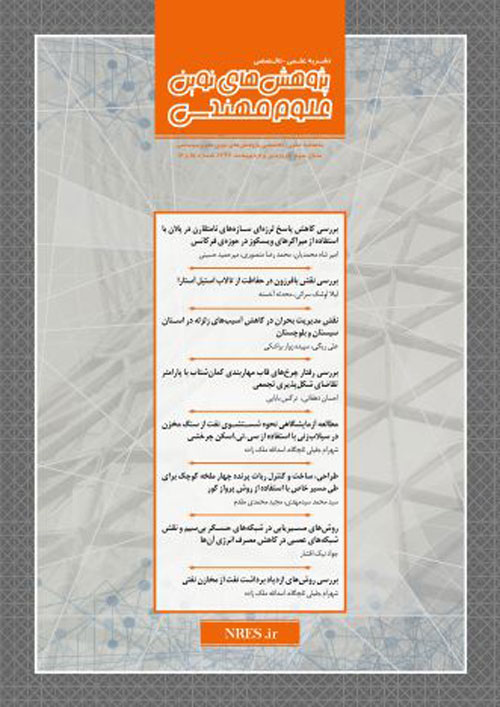فهرست مطالب

ماهنامه پژوهش های نوین علوم مهندسی
پیاپی 17 (خرداد 1397)
- تاریخ انتشار: 1397/03/21
- تعداد عناوین: 6
-
Page 1In this work, jet trajectory in the flow field of tangentially-fired furnaces (TFF) with square horizontal cross-sections is studied using three-dimensional computational fluid dynamics (CFD) simulations. A least-squares correlation for the trajectory of the coaxial fuel-air jets is suggested which can be very useful in future analysis of TFF. In order to verify the CFD solution procedure, a turbulent round jet injected into cross-flow is simulated. The calculated jet trajectory and velocity profile are compared with the experimental and numerical data of existing references and good agreement is observed. Results show that the trajectory of the coaxial fuel-air jets is neither affected by the inner (fuel) jet Reynolds number nor by the outer-to-inner jet momentum ratio.Keywords: Jet trajectory, tangentially-fired furnace, diffusion combustion, CFD
-
Page 13This paper presents a low phase noise source injection coupled quadrature oscillator (ICQO). Like most of the works which have been presented for parallel coupled quadrature oscillators (PC-QO), the presented IC-QO using passive components like capacitance instead of noisy active devices with casualties for coupling the oscillator circuits that lead to elimination of the phase noise due to the coupling transistors. The presented IC-QO also uses the re-filtering technique of the sideband noise. Furthermore, the second harmonic of the tail current source suppressed by creating high impedance in the tail, which applied for the proposed IC-QO to be more noiseless. Reducing the noise frequencies around 2ω0, leads to the amplitude of quadrature signals become larger and also the phase noise reaches to the lowest possible amount of noise level. To confirm, a 3.4 GHz proposed design of CMOS source injection coupled quadrature oscillator with LC noise filter structure in the tail is simulated. Using 0.18μm TSMC CMOS technology proved that the proposed structure with passive components and using LC filter shunted with tail current source exhibit a low phase noise of -157 dBc at 3MHz offset frequency and -187.2 dBc at 3GHz frequency. The obtained results show the agreement.Keywords: Injection Coupled, LC Quadrature Oscillator, RF CMOS, Passive Components, Phase Noise, Tail Noise Filter
-
Page 21A main problem in vector quantization (VQ) is codebook designation. The traditional method used for VQ codebook generation, is the Generalized Lloyd Algorithm (GLA). The efficiency of the GLA algorithm is hardly dependent on the initial codebook selection. But, GLA algorithm usually gets trapped into local minimum of distortion, resulting in a random codebook initialization. In this paper, an effective codebook initialization algorithm based on Kernel density estimation has been proposed. Experimental results show that the proposed algorithm not only improves the quality of generated codebook but decreases the computation time compared to the GLA algorithm.Keywords: Vector quantization, Codebook generation, GLA algorithm, Image compression, Kernel density estimation
-
Page 29In this study, removal of cadmium from aqueous solution was conducted by chitosan and MCM-41 nano composite. Response surface methodology (RSM) was used for modeling and optimizing the process, and to gain a better understanding of the process performance. Centered Composite Design (CCD) was used as the experimental design .Parameters effects such as temperature, pH, contact time, initial Cd(II) concentration and adsorbent dose on the adsorption process were studied. The numerical optimization revealed that the optimum removal (87.15%) obtained at ct/mcm-41 dosage of 0.1g, initial Cd (II) concentration of 20 mgL-1, contact time of 30 min, temperature 300c and pH of 6.Keywords: Aqueous solution, Cd (II) removal, Response surface methodology
-
Page 35In this paper, applications of SMES and STATCOM to improve the operation of large wind farm are investigated. The proposed control strategy of STATCOM is based on PWM control, both the angle and the magnitude of the converter output voltage. And the proposed SMES system is based on a PWM voltage-source converter (VSC) and a two-quadrant DCDC chopper using an insulated-gate bipolar transistor (IGBT). Considered power system consists of two groups of wind farm which are delivering power to an infinite bus through a transmission line with two circuits. Moreover, the proposed wind farm is 50MW, includes of 5 induction generators in each group which are based 5MW variable speed wind turbines driving squirrel cage induction generators. The space between turbines is 350m. PSCAD/EMTDC software is used to model and implement the power system. Simulation results show fine operation of the Wind farm with contribution of mentioned devices even when the severe fault has been applied.Keywords: Wind farm, SMES, STATCOM, VSC, DC-DC chopper
-
Page 47This paper summarizes the conclusions of experiments conducted on the adsorption of Co3 onto zeolite. The focus of the experiments was to establish the influence of the initial concentration of the metal ion solution on adsorption capacity of zeolite. Langmuir and Freundlich isotherm models were used to validate the experimental data. Adsorption isotherms of Co (III) ions obey the Langmuir equation that indicates the monolayer sorption of Co (III). The findings from this study on the cobalt adsorption behavior of nanostructure of zeolite may have potential applications in wastewater and water purification works.Keywords: cobalt, adsorption, natural zeolite, nanostructure


